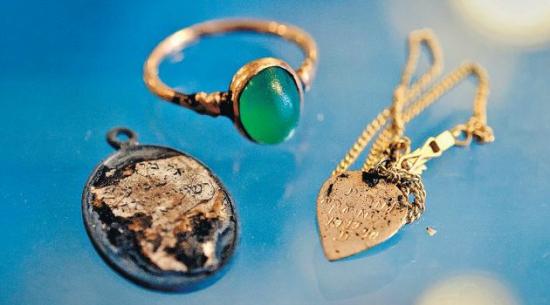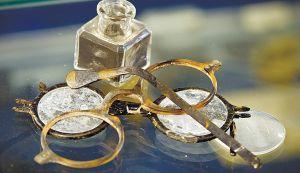Everyday Items Recall Horrors of Secret Holocaust Killings
Ofer Aderet
Source - http://www.haaretz.com/jewish-world/jewish-world-news/trove-of-everyday-items-reveals-lithuania-s-dark-holocaust-secret.premium-1.461851

Personal items uncovered in Kovno’s VII Fort in Lithuania.

The belongings of Jewish victims were buried under asphalt and garbage for seven decades.Photo by Michal Fattal
A young Lithuanian archaeologist reveals a dark secret hidden for 70 years: the remnants of the personal belongings of the Jews killed in the city of Kovno.
On the shiny glass table lay jewelry, coins and metal utensils - similar to those in a catalog of antiques. The years have left their mark on the items, but they are still in good shape. Some collector would probably pay a nice amount for them.
But these items are not for sale. It is doubtful whether anyone even would think of buying them if they knew where they came from. They were found about a year ago in Kovno, Lithuania, also known as Kaunas. Vladimir Orlov, a young local archaeologist, found the items - and revealed a dark secret hidden for 70 years.
At a 10-day seminar held at at The International School for Holocaust Studies in Yad Vashem, the Holocaust Martyrs' and Heroes' Remembrance Authority in Jerusalem for Lithuanian educators that ended Wednesday, Orlov presented his research in a talk: "The Beginning of the Holocaust in Lithuania (VII Fort Findings )."
Kovno is the second largest city in Lithuania. The archaeological site was found in one of the 10 fortresses built surrounding the city in the 19th century that were used as prisons. In the summer of 1941, some 4,000 Jews from the city were quickly gathered in the seventh fort and murdered. Some were shot using machine guns and others were killed by hand grenades.
Over the past seven decades, the personal belongings of the Jews killed there - eyeglasses, rings, pen knives, scissors and coins - were hidden by the dirt. Hebrew letters decorated some of the items, and are the only testimony as to the identity of their forgotten owners.
Orlov said he located the items based on historical documents and pictures that indicated the location. Some were found in a nearby well at a depth of three meters. Over the years the rain and snow had swept the items into the well. "We pumped out the water and sifted what we found," said Orlov.
The items found among the sand and stones were "the personal items of the victims," he said. A Jewish prayer book and bank documents were also found.
The weather was not the only thing that made discovering the items difficult over the past 70 years. After the Soviet Union took over Lithuania following the Second World War, the site was covered over with asphalt and was also used as a garbage dump. The stories about the site were forgotten as the generations passed. Only a few in Kovno knew the truth about the site, but they never spoke about it, said Orlov. It didn't interest anyone and no one researched it. There was barely any information available, he added.
Five years ago the Lithuanian Center for Military History, a private organization, bought the site. The original plans were to build a museum there with a center to study the area's fortifications. The organization's members, including Orlov, started to investigate the history of the site and very quickly realized that it served as a concentration camp during the Holocaust period.
"I thought it would be impossible to find anything there, other than 'a few thousand' were killed there," he said. "We made a goal of finding their graves."
After a year of searching they found the site: A mass grave of 4,000 murdered Jews.
Later, not far away, they found the personal belongings. The collection is not impressive or very big, said Orlov. There are only 25 items in total, but they are very important since they they prove the entire story was true, he said.
The nationalistic awakening in Lithuania in recent years, in which war criminals from the Nazi-occupation era are being honored as national heroes, makes such authentic evidence even more important. Alongside the victims' belongings were also items left by the murderers: Shell casings and bottles of alcohol.
Orlov, a computer engineer by training, is one of a group of 450 educators and researchers from Lithuania who attended the seminar at Yad Vashem's International School for Holocaust Studies. He managed on this visit to identify 89 names of the 4,000 victims from the Seventh Fortress. He was bothered that historians knew the names of the murderers, but no one knew the names of the victims.
"It's insane that the murderers live on in history while the victims remain anonymous," said Orlov. "We only found a few of the names, but that's better than nothing."
Germans did not carry out the mass murder at the site - that was organized and carried out from the beginning to the end by local Lithuanians. The provisional government in Lithuania, which existed between the end of the Soviet occupation and the time of the German occupation - after Germany attacked the Soviet union in the summer of 1941 - ordered the creation of the concentration camp at the site.
Everything was carried out by local residents. "Not everyone were criminals or from the lower class. Some were educated and had families," said Orlov.
Dr. Irit Abramski of Yad Vashem accompanied Orlov on his visit here. They share a language as Abramski was born in Lithuania and her mother was a Holocaust survivor of the Vilna ghetto. "All the family on her side was killed," she said. "Orlov discovered something completely new, which was unknown, and it is important to make it public knowledge."
The importance of the research is in who is conducting it: "Not us, the Jews, are telling [the story], but an independent Lithuanian researcher who revealed the role of the Lithuanians and their responsibility for the murders," said Abramski.